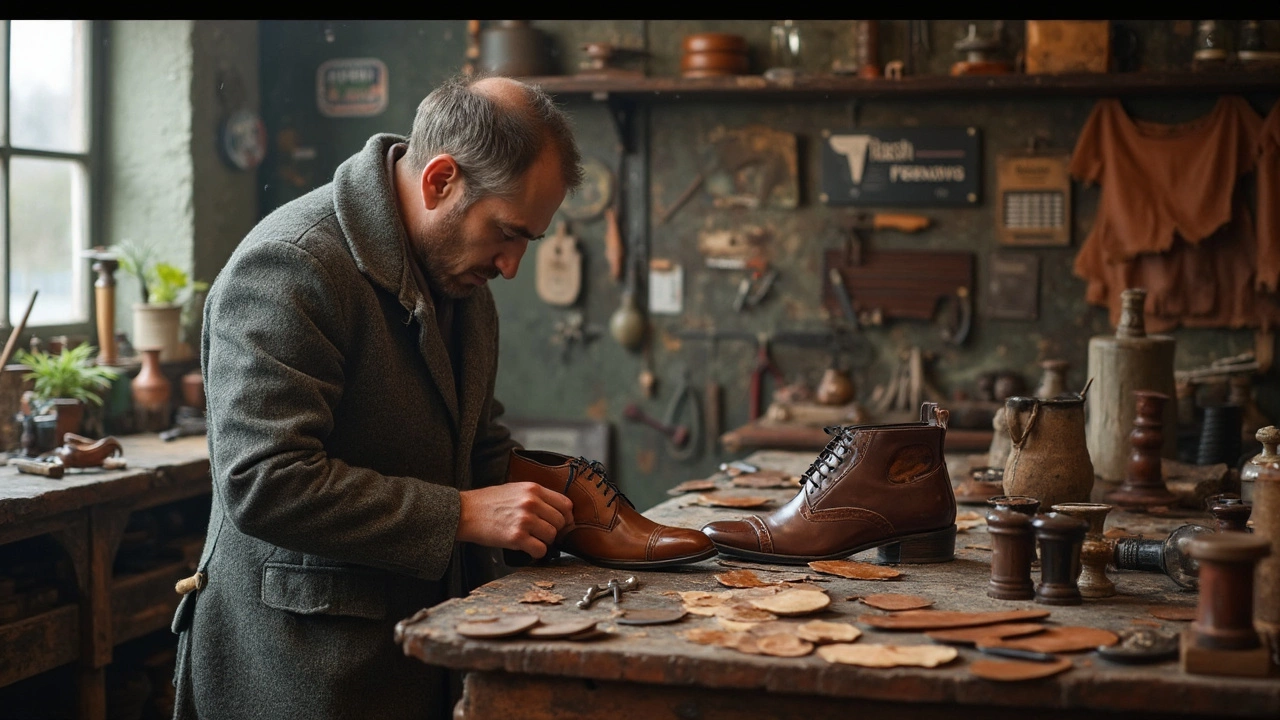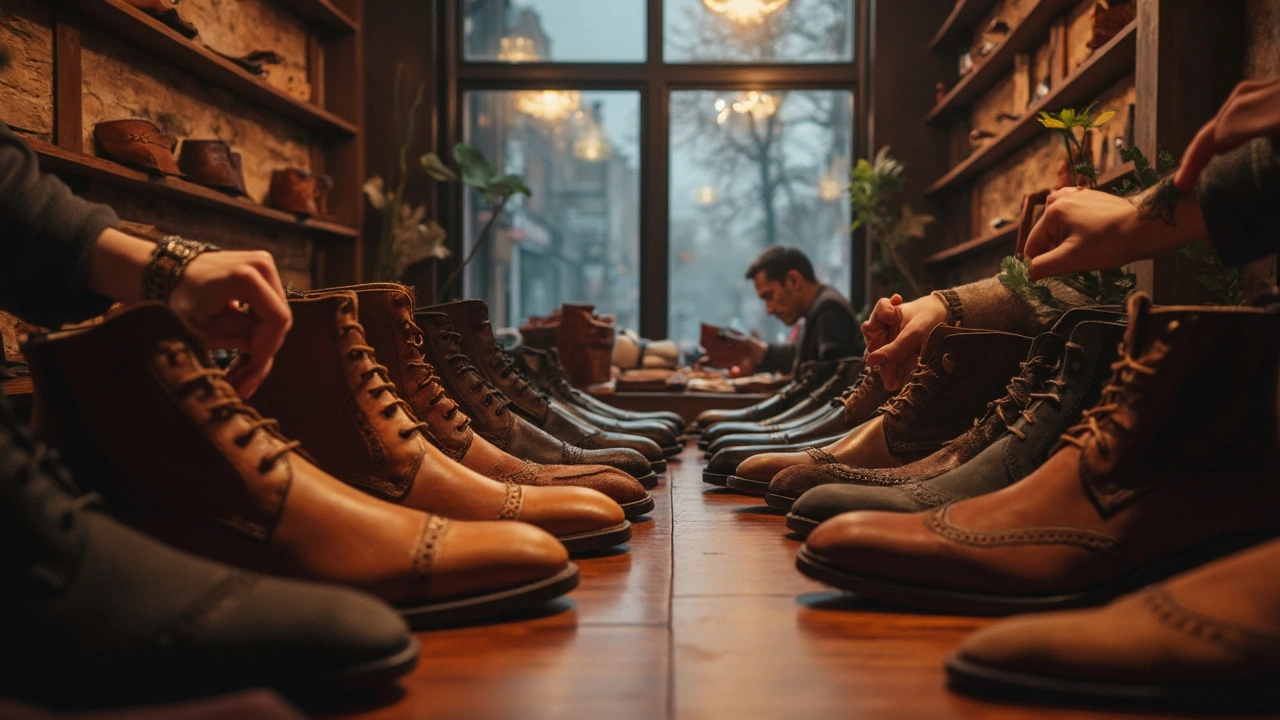Start looking for leather shoes in Ireland, and you'll hear folks toss around terms like 'full-grain' or 'top-grain' faster than you can say Temple Bar. But does it actually matter? The truth: yes, especially with how wild the Irish weather gets. Full-grain leather is known for being tougher and aging better than anything else—it holds up against those sudden rain showers you see from Cork to Donegal.
Plenty of premium Irish shoe shops, like Galway-based Dubarry or Louis Copeland on Wicklow Street, now put a big focus on full-grain or vegetable-tanned leather. These choices soak up less water (good news for anyone caught walking in Irish drizzle) and they actually look better the more you wear them. Lesser grades—like bonded or 'genuine' leather—miss out on this. They break down faster and never develop that classic shine locals admire during a stroll down Grafton Street.
- Full-Grain vs. Other Leathers: What Matters for Irish Conditions
- Irish Weather and Leather: Making Smart Choices
- Trusted Irish Shoe Brands Using Quality Leather
- How to Spot High Quality Leather Shoes When Shopping
Full-Grain vs. Other Leathers: What Matters for Irish Conditions
If you’re shoe shopping anywhere on the island, you’ll quickly notice how much folks value high quality leather—and that starts with full-grain. Full-grain leather is made from the very top layer of the hide, keeping the natural grain and all its tough little details. It’s the gold standard because it breathes well, stands up to daily wear, and handles the wet Irish weather better than anything else.
Why does this matter in Ireland? Well, it rains more than 200 days a year in parts of the west, and there’s no shortage of puddles, whether you’re hurrying for the DART in Dublin or exploring the stone streets of Kilkenny. Full-grain leather shows less damage from water and mud. After a quick brush and some conditioner, it bounces right back—unlike cheaper leathers, which can stain, crack, or warp.
Let’s break down the main types of leather you’ll come across on the Irish market:
- Full-Grain Leather: Toughest, most breathable, and ages best. Handles wet weather and scuffs with ease. It’ll look even better in two years than it did when you left the shop in Killarney.
- Top-Grain Leather: Slightly sanded to remove imperfections, a bit softer, but not as durable as full-grain. Decent for style, but doesn’t last as long in Irish muck and rain.
- Genuine Leather: Sounds good, but it’s usually made from leftover bits. Won’t last a busy winter in Limerick before it starts to fall apart.
- Bonded Leather: Avoid it for shoes. It’s basically leather dust mixed with glue. One soaked walk across St. Stephen’s Green and you’ll be sorry.
You’ll see the difference when you look close—full-grain feels supple but sturdy, and picks up a rich patina over time that gives it character. Local cobblers will tell you, investing in it means fewer repairs and a better fit year after year.
Here’s a handy comparison for Irish wear-and-tear:
| Leather Type | Water Resistance | Durability (Years) | Best For |
|---|---|---|---|
| Full-Grain | High | 10+ | Everyday, formal, country walks |
| Top-Grain | Medium | 5-7 | Casual, semi-formal |
| Genuine | Low | 2-4 | Occasional wear only |
| Bonded | Very Low | 1-2 | Budget, not for Irish weather |
If you really want your shoes to last through Galway rain or Dublin winters, keep your eyes out for full-grain. It fits the Irish climate, gives great value, and saves you the hassle of buying replacements every few years.
Irish Weather and Leather: Making Smart Choices
If you’ve lived in Ireland for any length of time, you already know the weather’s not shy about changing on you. Rain, mist, and those unexpectedly warm sunny breaks—sometimes all in a single walk from O’Connell Street to the DART. These swings can be rough on shoes, so picking the right leather isn’t just about looks here, it’s about getting real value and lasting comfort.
High quality leather, especially full-grain, is top of the list for Irish conditions. Full-grain keeps out water better than cheaper leathers—less chance you’ll end up with soaked feet—and keeps its shape even after constant damp, thanks to its natural fiber structure. Top-grain works, too, but it won’t age as nicely or hold up as long.
Let’s put the main choices side by side, based on what actually happens with Irish weather:
| Leather Type | Water Resistance | Breathability | Lifespan (Years, Avg Use in Ireland) |
|---|---|---|---|
| Full-Grain | Excellent | Great | 8-12+ |
| Top-Grain | Good | Moderate | 5-8 |
| Genuine/Bonded | Poor | Low | 1-3 |
Because even the best leather won’t handle Irish streets without care, here are a few smart moves you can make:
- Go for a shoe with storm welting or extra seam protection—most local makers offer this for a reason.
- Waterproofing sprays are popular, but don’t go overboard. Too much can block breathability and wreck natural shines.
- Rotate your shoes—don’t wear the same pair two days in a row. It gives the leather time to dry out, which is key with the Irish humidity.
- If you’re walking on salty winter streets, wipe shoes down at night. Salt leaves ugly stains and weakens leather over time.
Plenty of old-school Irish wisdom says to stuff sodden shoes with newspaper and leave them near—not on top of—a radiator. It works. Drying too quick actually ruins high quality leather, leaving it cracked and stiff. Slow and steady does the trick, even on stormy Galway nights.

Trusted Irish Shoe Brands Using Quality Leather
If you care about buying shoes that last, Ireland’s got some brilliant names worth knowing. Dubarry of Ireland is famous all over for their full-grain leather boots, especially with folks in rural areas and anyone who braves the outdoors. A lot of local vets and farmers swear by their Galway boots for a good reason—they’re tough, waterproof, and look sharp enough to walk into a Dublin pub without feeling out of place.
Then you’ve got Louis Copeland & Sons, better known for tailoring but quietly impressive in the leather shoe game. Their collaborations with Italian workshops are packed with quality, using calf leather that handles rain and scuffs better than basic options. For more everyday, affordable choices, Padmore & Barnes from Kilkenny make sturdy hand-stitched shoes using premium materials. Did you know they once made desert boots for Clarks? Even today, their stuff is made with proper hides, not mass-produced scraps.
If you’re wondering how these Irish brands stack up, check this for recent details:
| Brand | Main Leather Type | Key Product | Made in Ireland? |
|---|---|---|---|
| Dubarry | Full-Grain Leather | Galway Boot | Yes |
| Louis Copeland & Sons | Calf Leather | Dress Shoes | No (Italy) |
| Padmore & Barnes | Full-Grain, Suede | Original Boot | Yes |
Dermot O’Hara, a well-known cobbler in Galway, puts it simply:
"If you want your shoes to outlast the Irish rain, you need full-grain or nothing. Cheap leather falls apart much quicker."
If you want shoes from the high quality leather category, these Irish brands are a safe bet. They combine tradition, smart design for local weather, and real respect for materials. Not every shoe shop in Dublin or Limerick offers these, but the extra effort to find them pays off, especially if you hate replacing shoes every few months.
How to Spot High Quality Leather Shoes When Shopping
When you’re out browsing for leather shoes in Ireland—maybe on Henry Street or at Brown Thomas—knowing the real deal from just OK is huge. High quality leather isn't just about paying a big price tag. There’s a bit of detective work you can do right there in the shop, even before trying anything on.
First, give the leather a quick feel. Full-grain leather should feel slightly grainy but smooth, never plasticky or sticky. Press gently with your finger—good leather will wrinkle a little, sort of like your own skin. If it stays stiff or feels too shiny, it’s probably coated with something fake or low quality.
Next, take a whiff—real full-grain leather has a deep, natural smell, not a strong chemical or plastic scent. Most shoe shops in Dublin or Limerick don’t mind if you take a second to check this, as it shows you care about what you’re buying.
Flip the shoe over or peek inside. Look for clean stitching with zero loose threads. Handmade Irish shoes from places like Dubarry will have neat work with double stitching on stress points. If you spot glue seeping out at the join, or messy seams, the quality isn’t there.
Check out the sole. Leather soles tend to be a sign of serious quality, but for Ireland’s rainy streets, lots of well-made shoes have high-end rubber soles stitched, not glued. That’s a solid sign the maker knows what’s needed for local weather.
- Look for words like “full-grain,” “vegetable-tanned,” or “calfskin” on the tag or info card.
- Ask if the shoes are made in Ireland or Europe; it’s not a guarantee, but many local makers stick with higher standards.
- Try bending the shoe gently in your hands. A quality leather shoe is flexible but returns to shape. If it cracks or creases like cardboard, put it back.
And don’t get caught by the “genuine leather” label. In Irish shops, that phrase often means the lowest grade. Always go for full-grain or top-grain, and steer clear of bonded or synthetic mixes.
Remember, ask questions—especially from Irish sales staff in stores like Louis Copeland or Carl Scarpa. Shoppers here expect honest advice, and a good shop will be straight with you. Don’t rush it—finding the right pair of true high quality leather shoes is always worth the effort, especially with our unpredictable weather.
